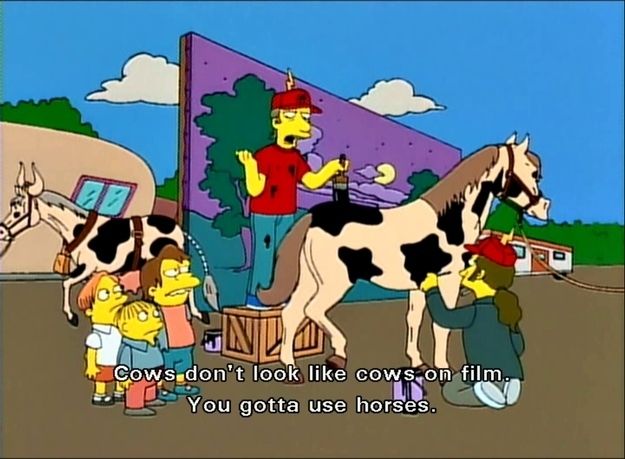Whoa mind blown
street wet, mind blown… door stuck? is that what comes next?
LMAO I don’t know how I’ve never seen that before, but I’m dying over here!
Wow, what a trip. There’s a bit further down the interview where they discuss Jean-Luc Godard’s “anti-semitism” which I’d never heard about. Looked it up and actually, he’s extremely anti-zionist, go figure. The more things change the more they stay still.
That’s not an American thing that’s a movie/TV making 101 thing, it’s for lighting reasons at night, I guess it’s this person’s first day watching movies.
I was literally in a movie recently with inexplicably wet streets, and the director said it was because the extra reflected light looks great on film.
Yeah, and it does. It’s WAY more eye catching.
by film do you mean vhs, betamax and video2000 or something else
Those aren’t film, they’re tape. Film is what’s in the camera or shown through a projector and are visible to the naked eye. VHS, Betamax, and video2000 are magnetic tape formats that aren’t viewable with the naked eye. Regardless, “on film” is still a universally acceptable term for “on the recorded video” no matter the format because terms stick around in industries
Bonus trivia: not all older videos were shot in “film”. That is why some 80’s music videos on YouTube look great, while others not so much (other things being equal). The “film” ones can be re-scanned at a higher resolution and retain a lot of the original detail if the originals are around.
Uh so what are older (I’m assuming before digital) videos shot on if not film?
*Wait do you mean like old tv shows? I think some of those were shot on tape.
IMAX.
Continuity. You can’t make wet streets dry, but you can make dry streets wet.
Plus it makes for nice reflections.
deleted by creator
Best answer
Water fall from sky
The streets are wet so it’s easier to perform stunt driving.
It’s the only way to make these godawful stroads look somewhat nice.
same reason it’s always raining during funerals
Seattle
That road is in way too good of shape to be Seattle
That is true. Seattle roads are shit
to encourage monorail.
Lol, if only the monorail was not only 2 stops from the space needle to downtown. I guess to encourage light rail and busses?
… it rained recently?
That’s sadness. Modern American cinema is not subtle.
Deleted
That’s just the road dew, don’t worry about it.
Also, Americans are too poor/cheap to spend money on proper infrastructure, so they use old closed asphalt and have poorly designed and maintained roads where the water just pools on top when it rains.
Pretty dramatic oversimplification that appeals to predetermined biases.
Here is a resource detailing the different types of asphalt mix and their appropriate use cases.
Particularly note the following:
[Open-graded] mixtures should only be used on high- or medium-traffic volume roadways with posted high speeds only.
Which directly refures the idea that using dense-graded asphalt is purely due to “Americans are too poor/cheap.” The benefits of open-graded asphalt mixtures are lost if you apply it to low speed roadways.
No argument against the poor maintenance part though. Cheers 🥯🥛☀️
That source has a pretty significant bias itself. It being from 2001 might be a clue as to why: before polymer-modified bitumen, there were many more downsides to using open asphalt mixes on anything but long, straight highways. That’s probably also why it only mentions hot-mix asphalt, which the Netherlands is basically banning next year for environmental reasons in favour of warm-mix. I REALLY hope this isn’t the latest version of this book.
It’s true that high-speed roadways more greatly benefit from open asphalt, but it’s very much not true that open-graded mixtures don’t have benefits at lower speeds. They still reduce road noise by 5-7 db even at 50kph speeds, and of course the benefits of less water on the road is substantial. The downside is that there is more fraying, so using it at traffic lights or roundabouts is not a great idea. Even with modern PMB mixes and SAMI treatmeants that reduce fraying pretty effectively (which didn’t really exist in 2001 when that source was composed), a stone-mastic asphalt is still the go-to for areas with a lot of turning or braking.
But most of all, it’s more expensive to build and to maintain, and since maintenance is already pretty crap in a LOT of places (having 6 or 7 lane accessroads doesn’t help there) using open asphalt is probably a bad idea.
Source: Married a Dutch engineer, worked on a lot of roadbuilding projects myself (admitedly not in the design phase, I do know what gets put where here in the Netherlands).
Thank you for sharing! I would be interested in more up-to-date resources if you have them. Additionally, I still believe that the “poor/cheap” element is not entirely accurate until further evidence is provided. You yourself seem to suggest that it is more related to the sheer size of freeways and interstates that make open-graded mixes cost-ineffective, which I agree with.
You yourself seem to suggest that it is more related to the sheer size of freeways and interstates that make open-graded mixes cost-ineffective, which I agree with.
No, what I said is that you can absolutely use open asphalt outside of freeways, but that the benefit is smaller. Whether or not you want to do it all depends on how you weigh your cost-benefit analysis. Many Dutch cities use it in the city for noise reduction, regardless of higher cost. But if you value things like noise and splash reduction less, then the cost-benefit will land more solidly on “don’t build expensive things”.
Thanks for the slight correction. Sorry for the misunderstanding.
I still believe that the “poor/cheap” element is not entirely accurate until further evidence is provided. You yourself point out that it is a matter of cost-benefit analysis, which can be tremendously swayed by land use (noise reduction matters less with lower density) and practical considerations (America is just… really really big).
What? You just made that up that has nothing to do with the question at habd
huh? which part did I make up?
This being a closed-asphalt mix? That’s pretty obvious, since there’s water pooled on top. That the road was poorly designed? It’s a 6 or 7 lane accessroad, by definition that’s poorly designed. That the maintenance is bad? There’s water pooling in dozens of places because either the road sagged from the weight of waiting cars (the lengthwise puddles) or from ripples caused by braking cars (widthwise puddles). Or that the US doesn’t spend money on infrastructure? I guess that’s debatable (6 lane accessroads don’t come cheap after all).
Not bothering to argue about Americans fucking up on infra investment, but I am curious why you keep calling that road an “access road” and make the generalization that having 6 or more lanes inherently makes it bad. Tell me more about this, because roads with that many lanes are a daily part of life when you live in a major metro area in the US (especially in the middle of the US where land is cheaper).
but I am curious why you keep calling that road an “access road”
Probably a bit of a holdover from Dutch civil engineering. We split roads here in three main types: The first type are “Flow roads” (stroomwegen) whose purpose is to have unimpeded traffic flow without obstacles. Think highways without level crossings.
The third type is the “Living street” (erftoegangsweg), which is mostly unmarked and has no signals, the kind of street that’s walkable and bikable, leading to houses and stores and parking areas.
And then there’s the thing in the middle, which is what you put between option 1 and 3, which is the (gebiedsontsluitingsweg), which literally translates to “area unlocking road”, but better translates to accessroad. It has level crossings with traffic lights or roundabouts, and serves to connect different areas like suburbs to town centers.
This road is some kind of deformed hybrid between 2 and 3, intended to connect different areas and moving traffic, but constantly interrupted by crossings and traffic signals. You have to stop two whole lanes of longer-distance traffic, just to get to a parking spot at a single store. As a result, you need a crazy-wide road with multiple turning lanes, just to make room for all the waiting cars. This contraption creates constant interaction between two intirely different types of traffic, and mixes two uses of roads that really don’t combine well. You shouldn’t have to stop multiple lanes of longdistance traffic just because I want to move from the pharmacist to the supermarket.
This one massive slab of asphalt could be a 2-lane area-unlocking-road with seperated exits leading to living streets. It would take far less road surface and massively improve the flow of traffic, because you’re not mixing fast through-traffic with slow destination-traffic.
I remembered a Cities Skyline youtuber mentioning this so https://road-safety.transport.ec.europa.eu/european-road-safety-observatory/statistics-and-analysis-archive/roads/road-classification_en
Flow, distributor, and access.
Dunno if that’s what they’re talking about, but so called stroads are a terrible idea. That is, roads which combine lots of fast through-traffic with many destinations like stores where people pull out of driveways. It’s a recepie for desaster.
perchance this is the birth of a future !fuckcars member, here’s hoping, take your time :)
Big fuck cars energy over here from an American. I’ve always loved visiting a walkable city, and having that not be in the cards for me where I live frustrates me greatly.
I’m a bit sleep deprived and the comment was only half on my screen.
I expected this to read “Americans are too poor/cheap to spend money on proper infrastructure, so they use (build) old wet roads instead of new dry ones.”
Your guys’ roads don’t sweat?
Because most major us cities water the plants in the medians after sunset
That or they straight up wash the street. Both happen once sun sets











